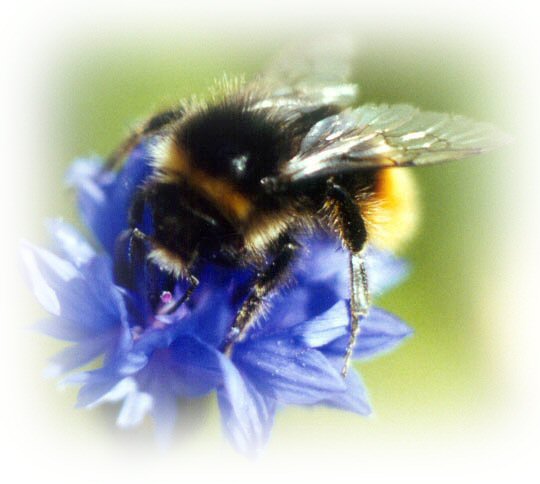Wildflowers to Attract Bees
Shop for plants to attract bees
There are more than 250 species of native bee in Britain, including 19 species of bumblebee - 25% of which are now endangered. In the last four years or so, one species of bumblebee has been declared extinct and another has become extinct along the south coast. Today, only 6 out of 16 species are easily found and even these have declined in numbers. Bumblebees are beneficial to farmers because of their importance in pollination, although it is, ironically, the reduction in suitable farmland habitat by these farmers that has aided the decline of the bumblebee. The Bumblebee Working Group and English Nature are encouraging farmers to allow or provide White Deadnettle growth in hedgerows, establish Red Clover in field margins (very important bumblebee plant), and to leave field margins uncultivated for a few years in order to provide hibernation sites and forage areas. Gardeners can do their bit too by providing a small meadow area in their gardens and leaving an area of rough grass, preferably by a hedge, for mice or voles to nest in - what's this got to do with bees? Queen bumblebees like to nest in old mouse and vole nests.
You can also buy bee nesting cylinders to attract Red Mason bees, who are excellent pollinators and non-aggressive. You can also buy special boxes for bumblebees to nest in. Interesting fact - a bumblebee can carry up to 60% of its body weight in pollen.
Agrimony (agrimonia eupatoria)
Angelica (angelica archangelica)
Anise Hyssop (agastache foeniculum)
Aubretia
Bergamot (monarda didyma)
Betony
Bird's Foot Trefoil (lotus corniculatus)
Black Horehound (ballota nigra)
Blackthorn (prunus spinosa)
Bloody Cranesbill
Bluebell (hyacinthoides non-scripta)
Borage (borago officinalis)
Bugle (ajuga repens)
Butterbur
Cardoon (cynara cardunculus)
Catmint (nepeta cataria)
Chicory (cichorium intybus)
Chives (allium schoenprasum)
Columbine (aquilegia)
Cornflower (centaurea cyanus)
Foxglove (digitalis)
Germander Speedwell (veronica chamaedrys)
Globe Flower (trollius europaeus)
Globe Thistle (echinops ritro)
Grape Hyacinth
Greater Knapweed (centaurea scabiosa)
Greater Stitchwort
Gypsywort
Hedge Woundwort (stachys sylvestris)
Herb Robert (geranium robertianum)
Hollyhock (althaea rosea)
Hound's Tongue (Cynoglossum)
Hyssop (hyssopus officinalis)
Ice Plant (sedum)
Lemon Bergamot
Lady's Smock (cardamine pratensis)
Lambs Ears (stachys byzantine)
Lavender (lavendula)
Lemon Balm (melissa officinalis)
Lesser Celandine
Lovage (levisticum officinale)
Marjoram (origanum majorana)
Marsh Marigold
Meadow Clary (salvia pratensis)
Meadowsweet (filipendula ulmaria)
Apple Mint
Mountain Mint
Mullein (verbascum)
Musk Mallow (malva moschata)
Oxlip
Painted sage (slavia horminum)
Pasque Flower (pulsatilla vulgaris)
Penstemon
Poached Egg (limnanthes douglasii)
Poppy (papaver)
Purple Loosestrife (lythrum salicaria)
Ragged Robin (lychnis flos-cuculi)
Red Clover (trifolium pratense)
Red Valerian (centranthus ruber)
Rock Rose (helianthemum mummularium)
Rosemary (rosmarinus officinalis)
Sainfoin (onobrychis vicifolia)
Selfheal (prunella vulgaris)
Small Scabious (scabiosa columbaria)
Spiked Speedwell (veronica spicata)
Sweet Cicely
Sweet William (dianthus barbatus)
Teasel (dipsacus fullonum)
Thyme (thymus)
Tickewwed (coreopsis)
Toadflax (linaria vulgaris)
Valerian (valeriana officinalis)
Viper's Bugloss (echium vulgare)
White Clover
Wild Basil (clinopodium vulgaris)
Wild Clematis (clematis vitalba)
Wild Mignonette (reseda lutea)
Wild Privet (ligustrum vulgare) Yellow Archangel
Yellow Archangel
Yellow Flag Iris (iris pseudacorus)
Yellow Loosestrife
 The English Cottage Garden Nursery
The English Cottage Garden Nursery